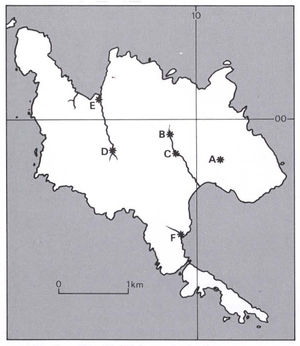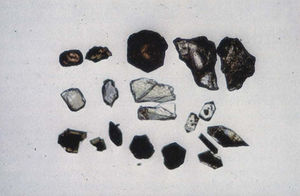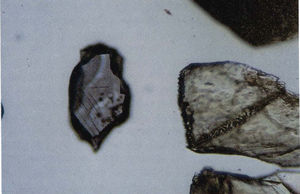Mineralogy of stream sediments of Hirta - St. Kilda: an illustrated account of the geology
| From: Harding, R.R. and Nancarrow, P.H.A. 1984. St. Kilda: an illustrated account of the geology. BGS Report Vol. 16, No. 7. Keyworth: British Geological Survey.]. |



Chapter 18 The mineralogy of stream sediments on Hirta
Keywords: heavy minerals, exotic minerals, mineral origins
Small pockets of sediments have been deposited in steps and hollows along the stream beds that drain Hirta. The contents and nature of these sediments reflect the mineralogy and geochemistry of nearby intrusions and also constitute a partial record of the development of the form and shape of the island. Stream sediments are natural collections of material from all parts of the catchment area and contain concentrations of the minerals which are most resistant to weathering and abrasion. The denser minerals are further concentrated by the winnowing effect of turbulent flowing water. Although relative abundances of minerals in the sediments and the source material are therefore not directly related, comparison may be made on a broad scale between one catchment and another, and it is possible to distinguish between indigenous minerals and those whose original source was outside the present catchment.
Only a small proportion of the sediments can be examined in detail and the sampling procedure used on St Kilda was the same as that developed for use in regional geochemical mapping by the Applied Geochemistry Unit of IGS (Plant and Moore, 1979). Sampling sites were carefully chosen to be representative of a particular catchment, and to avoid where possible, sources of contamination such as dwellings or industrial activity. Even in a location as remote as St Kilda metallic particles from crashed aircraft and fragments from building work on the hilltops can contaminate the sediments. Locations of the St Kilda sites are shown in (Figure 32)
The tools used in sampling include a small pointed shovel (with all traces of paint removed), nylon sieves of 2.0 mm and 150 µm mesh, in wooden frames, and a shallow wooden dish for panning. At the sample sites notes are taken of various factors which may affect the sedimentation, including stream flow conditions and the nature of bedrock and any drift deposits nearby. The top few centimetres of sediment are removed to dispose of recent organic contamination and transient precipitates, and pebbles and boulders examined and sampled if they show any interesting features (such as mineralisation; possible erratics). A sample of sediment is passed through the sieves, the < 150 µm fraction being collected in the wooden dish and retained, while the > 2.0 mm material is discarded. The 150 µm - 2.0 mm fraction is then panned to remove the bulk of the lighter minerals such as quartz and feldspar, and the heavy concentrate retained. Panned concentrates of the size fraction 150 µm - 2.0 mm were examined in detail to determine the nature and provenance of the mineral grains. The samples were subdivided in three ways; firstly into size fractions by sieving, secondly according to their magnetic susceptibility, by hand magnet and electromagnetic separator, and thirdly by density using a heavy liquid (bromoform SG 2.89). Most minerals were readily identified under the binocular microscope, but in addition a selection of identified and unidentified minerals were analysed qualitatively with the electron microprobe and further quantitative analysis or X-ray diffraction analyses were undertaken where necessary for positive identification.
Mineral grains in the panned concentrates are of two types: (i) indigenous minerals which occur in rocks outcropping within the catchment area of the sampling site; (ii) exotic minerals not known in rocks on St Kilda, forming at the most only a few percent of each concentrate.
In the An Lag concentrates, the most abundant indigenous minerals are angular to subrounded clinopyroxene and mottled pink translucent zircon grains with smaller amounts of euhedral magnetite. Very few of the grains are larger than 0.5 mm. The pyroxenes, probably derived mostly from late basic sheets, have a range of composition, with a distinct group of clear green angular diopside grains, many of which contain Cr. The most numerous zircons are commonly broken euhedra of simple prism-and-pyramid form, showing little sign of abrasion. They are chemically very pure, and only a few have a trace of Hf or Th, a characteristic of the zircons found in druses in the Conachair granite. A few zircons have thin discontinuous coatings or minor intergrowths of xenotime. A second group of zircons consists of sharply euhedral, very pale yellow transparent crystals, often with inclusions. A third group consists of well rounded pink, dark red, and brown zircons and these are much rarer. Euhedral anatase was found in a variety of forms ranging from very dark, sharply-pointed bipyramidal crystals to thin square plates showing strong green colouring, similar to crystals occurring in the Conachair Granite. Most of the anatase contains niobium, up to a maximum of about 7 wt% Nb2O5. Other indigenous minerals include a variety of amphiboles, epidote, orthopyroxene, chlorite, biotite, ilmenite, chromite, apatite, rutile, sphene and chevkinite. The most abundant exotic minerals in An Lag are garnets and these show a wide range of both composition and form. Although less than 0.25 mm in diameter the clear pink, red, orange-brown and lilac grains are conspicuous in the panned concentrates even though they form a very small proportion of the sample. Most are angular to subrounded fragments, some are well rounded grains, and a few unworn dodecahedra. The composition ranges from almandine, almandine-pyrope, almandine-spessartine through andradite, grossular-andradite, to spessartine. Andalusite, kyanite and sillimanite (polymorphs of Al2SiO5), staurolite, and a few small angular fragments of clear blue corundum also occur. Minerals of uncertain origin, but which could be derived from rocks on Hirta, are tourmaline, including euhedral stumpy prisms and rounded grains, goyazite (a single subrounded grain) and fergusonite (three angular or subhedral grains).
Magnetite is the commonest indigenous mineral in the panned concentrates from Abhainn Mhor and generally occurs as angular fragments, with lesser amounts of ilmenite, pyroxene, and amphiboles. Apatite, biotite–phlogopite, chlorite, chromite, epidote, olivine, prehnite, pyrite, rutile, and sphene are of rarer occurrence and all are typical accessory and secondary minerals in nearby basic intrusions. Exotic minerals are mostly garnets, with grossular and almandine-grossular occurring in addition to those types found in An Lag. Staurolite is also present with a few grains of pale blue corundum ranging from clear angular to 'frosted' subrounded shapes.
In Abhainn a Ghlinne Mhoir the suite of indigenous minerals is similar to that found in Abhainn Mhor. However, exotic grains are very scarce and are mostly almandine-pyrope, with some grossular-andradite.
The range of indigenous minerals present in Abhainn Ruaival is similar to that in Abhainn Mhor, although mica, chlorite, prehnite and sphene were not found. A few small (< 0.25 mm) angular, subhedral fragments of clear blue spinel are however present. Angular to subrounded garnets are the most common exotic mineral. They form two distinct groups, one consisting of pale pink almandine-pyrope and almandine-spessartine, including two euhedral almandine crystals, and the other consisting of orange-brown grossular-andradite grains. Rare angular to subrounded grains of staurolite, andalusite, and tourmaline (black, and pleochroic green–brown) are also present.
Most of the heavy minerals in each stream sediment sample were locally derived. Many of these grains show very little evidence of abrasion, and have probably been moved by running water or solifluction very short distances downslope from their source rock. In contrast to these, many exotic mineral grains and also some zircon, rutile, and tourmaline grains show evidence of prolonged abrasion. The garnets in particular, exhibit a wide range of characteristics, both in grain shape and composition. These features suggest that the history of the grains may be quite complex, some having existed as detrital grains for comparatively long periods. The compositional variation of the garnets and the nature of other foreign mineral grains indicates that the exotic heavy mineral suite was derived from two types of metamorphic rock. Corundum, andalusite, andradite, grossular-andradite, and grossular most commonly occur in contact metamorphosed rocks, the first two minerals in altered aluminous sediments, the garnets characteristically in skarn or calc-silicate hornfelses. The remaining exotic minerals — sillimanite, kyanite, staurolite, tourmaline, pyralspite, almandinegrossular and spessartine — were most likely derived from medium to high-grade regional metamorphic rocks.
The work of Sutherland and Ballantyne (1982) suggests that the earliest, pre-Devensian glaciation of St Kilda was responsible for introducing foreign rock fragments which were subsequently reworked into locally derived glacial and periglacial deposits (pp. 30–31). It is not necessary to look far beyond the shelf surrounding St Kilda for a source of the exotic minerals which are found in stream sediments. The regional metamorphic suite of minerals were most likely derived from the Lewisian basement which Jones (1981) suggests is at or near to the submarine surface east of St Kilda.
Jones also suggests that a belt of Mesozoic sediments resting on the Lewisian basement extends to the northeast and south of St Kilda, and westwards is covered by a seaward-thickening sequence of Cainozoic sediments. By analogy with the Inner Hebrides, particularly Skye, the Mesozoic sediments, overlain by Tertiary basic lavas, may well have provided the high level country rock into which the St Kilda complex was intruded. Both pelitic and calcareous Mesozoic lithologies appear to have been thermally metamorphosed, producing a characteristic heavy mineral suite. These minerals must be locally derived, possibly from a roof pendant, or high level xenoliths, which were eroded by early glacial activity and deposited in a local till which was subsequently reworked.
References
| At all times follow: The Scottish Access Codeand Code of conduct for geological field work |